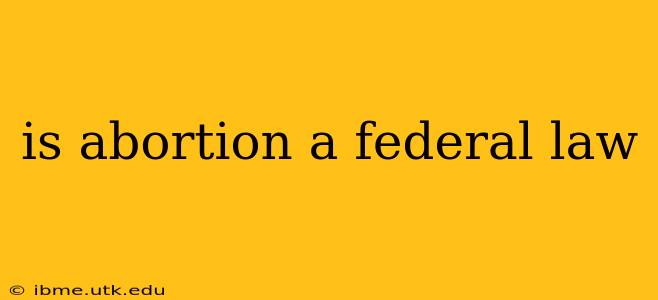The question of whether abortion is a federal law in the United States is a complex one, with the answer being a resounding no, but with significant nuances. There's no single federal law that either explicitly legalizes or bans abortion nationwide. Instead, the legal landscape is shaped by a combination of Supreme Court rulings, federal statutes, and state-level laws, creating a patchwork of regulations across the country. Understanding this multifaceted situation requires delving into the history and current state of abortion rights in the US.
What Supreme Court Cases Shaped Abortion Laws?
The legality of abortion in the US has been heavily influenced by Supreme Court decisions, most notably:
-
Roe v. Wade (1973): This landmark case established a woman's constitutional right to an abortion, based on the right to privacy under the Fourteenth Amendment. This ruling created a trimester framework, granting states more regulatory power as the pregnancy progressed.
-
Planned Parenthood v. Casey (1992): This case affirmed the right to abortion established in Roe v. Wade but replaced the trimester framework with the "undue burden" standard. This means states could not place substantial obstacles in the path of a woman seeking an abortion before viability (the point at which a fetus can survive outside the womb).
-
Dobbs v. Jackson Women's Health Organization (2022): This ruling overturned Roe v. Wade and Planned Parenthood v. Casey, eliminating the constitutional right to abortion and returning the authority to regulate abortion to individual states. This decision significantly altered the legal landscape, leading to a wide range of state-level laws, some banning or severely restricting abortion access, while others maintaining or expanding access.
What Federal Laws Affect Abortion Access?
While there's no single federal law directly banning or legalizing abortion, several federal laws indirectly influence access:
-
Hyde Amendment: This legislative rider prohibits the use of federal funds (Medicaid) to pay for abortions, except in cases of rape, incest, or when the mother's life is endangered. This has disproportionately impacted low-income women's access to abortion.
-
The Affordable Care Act (ACA): While the ACA doesn't directly address abortion, it impacts access indirectly. The law's expansion of health insurance coverage affects the number of people with insurance that could cover abortion services. However, restrictions on federal funding for abortion remain in effect under the Hyde Amendment.
What are the Current State Laws Regarding Abortion?
Following the Dobbs decision, state laws on abortion vary dramatically. Some states have near-total bans, with narrow exceptions for the life or health of the mother. Others have maintained or expanded access to abortion. This variability has led to significant disparities in abortion access across the country, with residents of some states facing significant barriers to obtaining abortion services while those in other states have relatively easy access.
How Does the Federal Government Still Impact Abortion Access?
Even after Dobbs, the federal government still holds influence:
-
Judicial Appointments: The appointment of federal judges, including Supreme Court justices, shapes the interpretation and enforcement of abortion-related laws.
-
Federal Funding: Federal funding for reproductive health programs, including those offering family planning services, can influence abortion access, either directly or indirectly.
-
Interstate Travel: The federal government's role in regulating interstate travel could play a role in discussions about access for individuals travelling from states with restrictive laws to those with more permissive ones.
What are Common Arguments For and Against Abortion Rights?
The debate surrounding abortion is deeply complex and involves deeply held moral, ethical, and religious beliefs. Arguments in favor of abortion rights frequently emphasize bodily autonomy, reproductive freedom, and socioeconomic considerations. Conversely, arguments against abortion often focus on the moral status of the fetus, religious beliefs, and the sanctity of life.
This overview highlights the complicated interplay of federal and state laws, judicial decisions, and ongoing political debates that shape abortion access in the United States. The legal landscape is ever-evolving, so staying informed about changes in state and federal policies is crucial.
